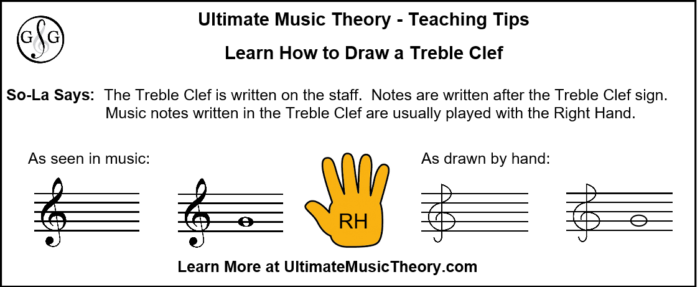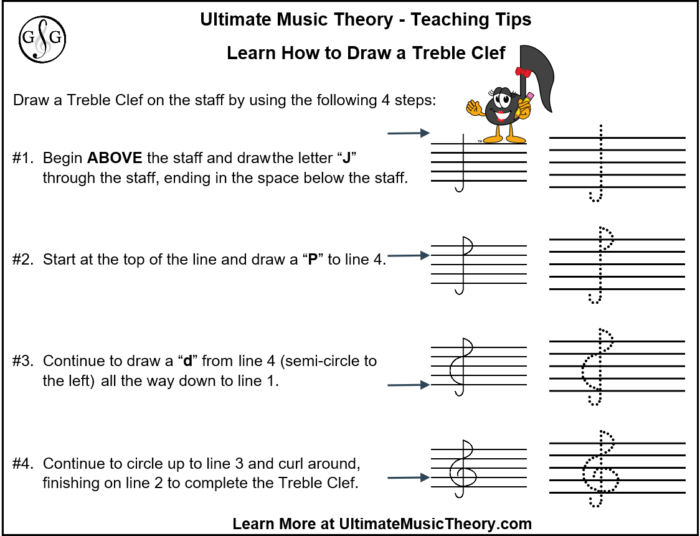Learn How to Draw a Treble Clef

Learn How to Draw a Treble Clef
There are many ways (and tips) to teach how to draw a Treble Clef. As a Teacher, I want to set an example to my students so that they learn how to draw a Treble Clef properly, easily and yes correctly!
Did you know that it is actually important to draw the Treble Clef properly - in a specific way for specific reasons?
As Teachers, we can teach our students how to draw a Treble Clef sign properly. Actually, we need to teach our students how to draw them properly! Theory is about the correct notation of music. So, let's be careful and do this properly.
Who Drew the First Treble Clef?
This picture from Wikipedia and The Harvard Dictionary of Music shows the evolution of what we now call the Treble Clef:

Musical notation began near the end of the 9th Century. Gregorian Chants were first written out using "neumes". Neumes were simply dots and dashes above the text that indicated changes in pitch.
By the end of the 10th Century, you could actually work as a Musical Scribe, writing out with increased precision the music of the Church.
To make the pitch of the written music relative to the pitch at which it was to be sung, scribes added a horizontal line to indicate a base pitch. At the beginning of this line was written a letter. F, C and G were the 3 most common pitches.
Ask your students to find those Landmark Pitches on the piano. Hint - they learned them in PREP 1 Rudiments!
By adding more lines, the neumes (or early notes) could be written to show direction and changes in the pitch. This is how the Musical Staff started!
Until the Industrial Revolution and the invention of the Printing Press, there were a lot of variations on how the Treble Clef was drawn. Eventually the version of the Treble Clef that we see today became the norm in printed music.
You can read about the full history of the evolution of the Treble Clef online at the Smithsonian Magazine.
10 Composers and Their Treble Clefs
 Okay - I guess if you are "famous", you don't have to learn how to draw a Treble Clef Properly!
Okay - I guess if you are "famous", you don't have to learn how to draw a Treble Clef Properly!
This picture was sent to me on Facebook and I wanted to share it with you.
But it is interesting to see how many different ways Composers wrote a Treble Clef. I tell my students that "just because a composer wrote it that way does not mean that it is right".
It is very important to draw a Treble Clef Properly!

Why Should We Draw a Treble Clef Properly?
The Treble Clef is also known as the G Clef. We need to draw a Treble Clef properly so that it fulfills it's purpose - pitching G on the staff.
Did you know that when we draw a Treble Clef properly, we actually pitch 2 different Gs?
When your student asks why they need to draw a Treble Clef properly, you can explain to them that it helps pronounce the pitches of the notes properly!
If you don't pitch these two Gs, then your music will not be pronounced properly!

Avoid Pet Peeves through Proper Pronunciation Practices (or how to say my name!)
Would your student like it if you, their teacher, mispronounced their name? What if their name was Scott and you wrote Scoff. Sure, it is just a little swoop on top of two letters, but it changes the pronunciation of the name! (PS - my husband's name is Scott!)
One of my many Pet Peeves is mispronouncing my name. I don’t mind if you mispronounce my name the first time. However, after I have explained how to say it, it becomes a Pet Peeve if you keep mispronouncing it.
Shelagh is pronounced like “Sheila”, just spelled the Gaelic way.
McKibbon (my married name) is pronounced “Mi-Ki-Bun”. There is no “G” in it. For some reason, I seem to get McGibbon a lot…
U’Ren (my maiden name) is pronounced “You-Wren”. I am a descendant of King Urien Rheged, a late 6th-century king of Rheged, an early British kingdom of the Hen Ogledd (northern England and southern Scotland). Cool, eh?
Can I tell you a secret? Glory often gets called Gloria. Her real name is Glorianna though, but please just call her Glory!
Ask your students if anyone ever has trouble pronouncing their names? If it happens a lot, I bet that it has become a Pet Peeve.
I like to explain to my students that mis-writing the Clef is like mispronouncing the Clef Name – and it is a Musical Pet Peeve.
How to Pronounce the Treble Clef
The Treble Clef is not pronounced Trouble or Tribble (although the Trekker in me likes that one…the Trouble with Tribbles…okay, if you are not a Trekker, you won’t get that one. Sorry).
"Treble" is pronounced "Treb-hul" (it is hard to write that "bll" sound - remember that it is not a "bill" sound, but a "bull" sound).

How to Draw a Treble Clef
Students do not need the thicker and thinner lines, or any of the angles, created by the printed font.
In order to draw a Treble Clef properly, they can use the simple steps outlined in the Music Theory Beginner A Workbook on Page 52 and the Prep 1 Rudiments Workbook on Page 12.
Draw a Treble Clef Properly - 4 Simple Steps:
- Begin above the staff (in that upper G space) and draw the letter "J" through the staff, ending in the space below the staff.
- Start at the top of the line and draw a "P" to line 4.
- Continue to draw a "d" from line 4 (semi-circle to the left) all the way to line 1.
- Continue to circle up to line 3 and curl around, finishing on line 2.

Practice Drawing Perfect Treble Clef Signs on the UMT Whiteboard!
My students love using their Whiteboards to draw Treble Clefs!
Have your students use their Ultimate Music Theory Whiteboard to practice drawing their clef signs.
A properly drawn clef allows for proper pitch placement on the staff…and is just as important as pronouncing their own names correctly!
Order your Whiteboards today!
- LEARN FASTER – Use on any device, phone, tablet, computer
- EXPLORE – Identify written & audio notation
- PLAY – Sight Reading and Ear Training Games and much More!
Students will LOVE hearing exact pitch and pronunciation of terms.
Students will be INSPIRED to use their imagination while building a foundation in Ear Training and Sight Reading.
The One and ONLY Music Theory App & Matching Workbook!
Keep on Learning... With a Smile and a Song!
Shelagh McKibbon-U'Ren



Hello Shelagh and Glory.
I love your theory explanations. They make so much sense to the children. I was amused by the name pronunciations also, but …….. the one that I probably get wrong is St Germain, and that is still a mystery. I lived in Paris for several years and in France, and possibly Quebec, it is pronounced “San Share man” or similar phonetically, whereas in Canada other people with the last name St. Germain pronounce it ‘Saynt Jurr mane’. I am not sure how yours should be Glory. This has absolutely nothing to do with music really, but only with reference to the “trouble cliff” which my little JK aged children usually think that it is!!
Helen, I love the “Trouble Cliff”!!!! That is priceless!
As for St. Germain, it is pronounced the “Canadian” way – “Saynt Jurr mane”.
Thanks so much for writing!
Shelagh
Hi Shelagh – I loved your post on the treble clef – I like all your posts, we really think the same way about stuff. Do you know how many kids I get who have been taught in school ‘music’ class by a teacher with no music background to draw their treble clefs in one swooping line, pencil never leaving the paper, from the bottom? Yikes. I like your comparison of the letters ‘t’ and ‘f’ – it does make a difference!
I have a couple of comments to add to the discussion. First, I always chat to the student as I draw the treble clef, and I use the same patter every time. I call it ‘Mrs. Treble G Clef’ (because she sings in a higher voice and shows us where the Gs are). I say, ‘first we make a J for jellybean’. Then instead of a “P” I call the first curve of the next line a “D” for Daddy or Donut – whatever – and I point out that it crosses the J on the line for the note D. I refer to the next section as a body for Mrs. Treble G Clef. It is a (backwards) D, but I wonder if calling it a D might confuse the occasional child who wants to draw the treble clef backwards anyway? I’ve had a few students who tend to do that. I do like your specific instruction as to where to finish – again, I’ve had kids who just keep circling and circling – can’t be too fancy, in their opinion, the more circles, the better!
This is a bit of an aside, but moving ahead to remembering which direction to put the flags on the stems of eighth (sixteenth, etc.) notes – I draw lips on Mrs. Treble G Clef and she blows those pesky flags the right direction, regardless of the stem orientation.
Also, for about a year I had that picture of the ‘famous’ treble clefs up in my studio (along with other musical jokes and cartoons) – my students got a certain amount of delight in noticing just how sloppy those treble clefs were, and took pride in the superiority their own treble clefs (‘trouble cliffs’ – I love that one too)!
Deb Miller-Cushon
Wow really helped me to draw a treble clef.
Do you ever talk about how the top & bottom loops show 2 additional locations of Gs?
Sure do!